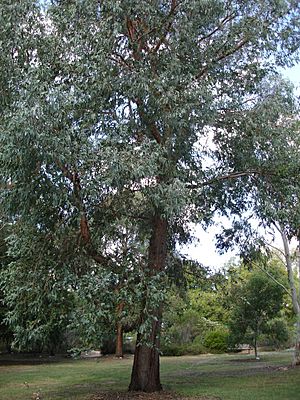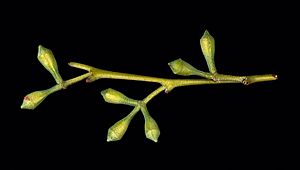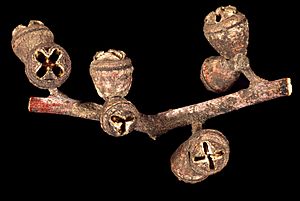Bogong gum facts for kids
Quick facts for kids Bogong gum |
|
|---|---|
 |
|
| Eucalyptus chapmaniana in Maranoa Gardens | |
| Scientific classification | |
| Genus: |
Eucalyptus
|
| Species: |
chapmaniana
|
The Eucalyptus chapmaniana, also known as the Bogong gum, is a type of tree found only in the mountain and eastern parts of Australia. It's a small to medium-sized tree. Its trunk has rough, tough, and cracked bark. The branches have smooth, light brown to grey bark that often peels off in long strips. The grown-up leaves are shaped like a spear or are slightly curved. Its flower buds grow in groups of three, and its fruit looks like a cone or a bell.
Contents
About the Bogong Gum
The Bogong gum is a tree that usually grows to be about 30 to 35 meters (about 100 to 115 feet) tall. It has a special woody swelling at its base called a lignotuber, which helps it regrow after fires.
Bark and Leaves
Most of the tree's trunk is covered in rough, tough, and slightly cracked bark. This bark is usually grey or brownish-grey. The bark on the branches is smooth and can be light brown or pale grey. It often peels off in long ribbons.
Young Bogong gum plants and new shoots have leaves that are directly attached to the stem (not on a stalk). These leaves are egg-shaped to almost round, measuring about 20 to 95 millimeters (0.8 to 3.7 inches) long and 18 to 70 millimeters (0.7 to 2.8 inches) wide. They grow in pairs opposite each other.
Grown-up leaves are arranged alternately along the stem. They are shaped like a spear or are slightly curved. These leaves are about 140 to 300 millimeters (5.5 to 11.8 inches) long and 17 to 48 millimeters (0.7 to 1.9 inches) wide. Each adult leaf has a stalk, called a petiole, which is about 13 to 37 millimeters (0.5 to 1.5 inches) long.
Flowers and Fruit
The flower buds of the Bogong gum grow in groups of three. They are found where the leaves meet the stem, on a short stalk called a peduncle, which is about 5 to 9 millimeters (0.2 to 0.4 inches) long. Each individual bud is on an even shorter stalk, called a pedicel, about 2 to 3 millimeters (0.08 to 0.12 inches) long.
When the buds are ready, they look like clubs or diamonds. They are about 7 to 9 millimeters (0.28 to 0.35 inches) long and 5 to 7 millimeters (0.2 to 0.28 inches) wide. The top part of the bud, called the operculum, is shaped like a cone or has a beak-like tip.
The Bogong gum flowers from January to March. Its flowers are white. After flowering, the tree produces a woody fruit. This fruit is a capsule that looks like a cone or a bell. It is about 5 to 9 millimeters (0.2 to 0.35 inches) long and 7 to 10 millimeters (0.28 to 0.39 inches) wide.
How it Got its Name
The Eucalyptus chapmaniana was first officially described in 1947. A scientist named Alexander Kenneth Cameron wrote about it after finding a sample near Bogong, a place in Australia. His description was published in a science magazine called The Victorian Naturalist.
The tree's special name, chapmaniana, was given to honor Wilfrid Chapman (1891–1955). He was the person who first noticed this unique type of eucalyptus tree.
Where it Grows
The Bogong gum lives in wet forests and woodlands that have grass or shrubs. It often grows on steep slopes in the cold mountain areas of Victoria and the far southeastern part of New South Wales.
In Victoria, you can find it along the highest parts of the Great Dividing Range, between places like Jamieson and Benambra. It also grows on Mount Buffalo and Pine Mountain. In New South Wales, it is only found south of Khancoban.
Gallery
-
A Bogong gum tree in Kew Gardens
See also
 In Spanish: Eucalipto bogong para niños
In Spanish: Eucalipto bogong para niños






